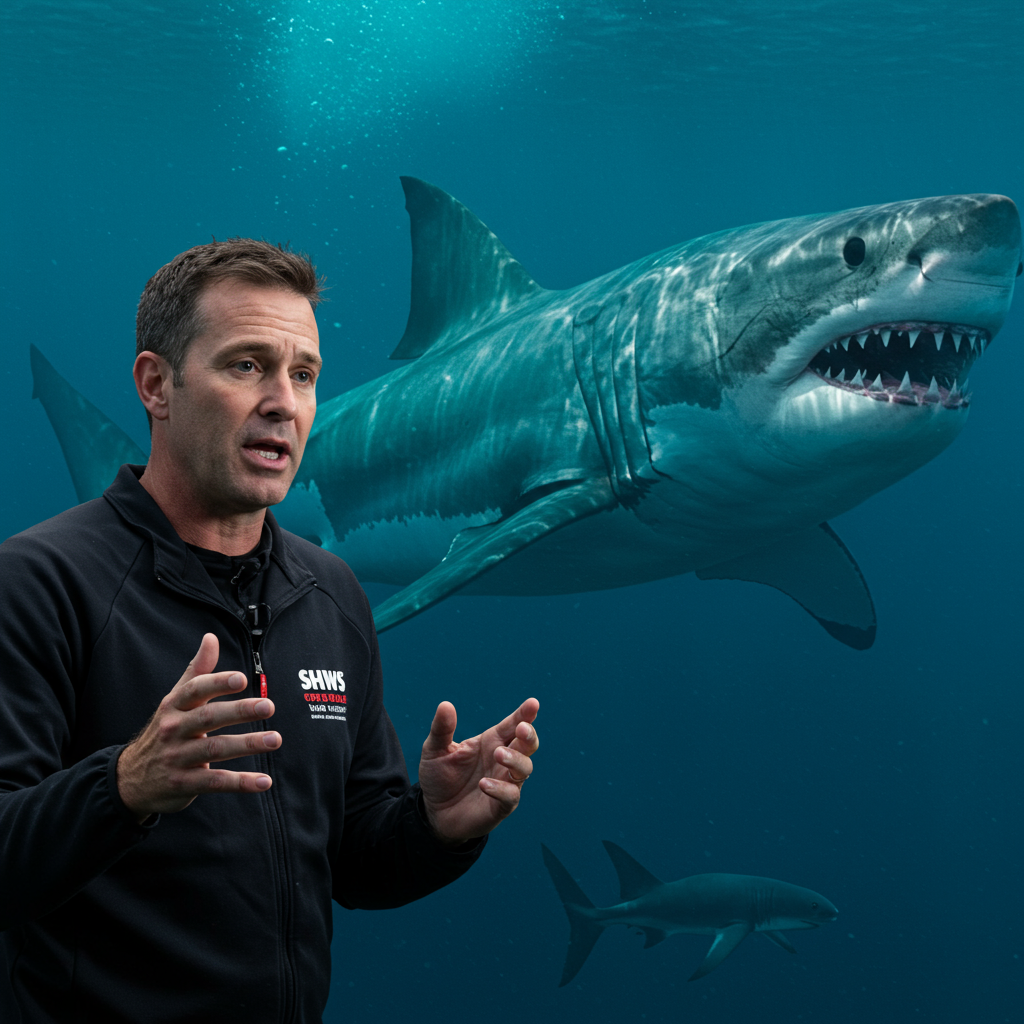Fifty years ago today, Steven Spielberg’s Jaws, based on Peter Benchley’s bestselling novel, permanently changed our relationship with the ocean. This cinematic landmark didn’t just redefine the summer blockbuster; it etched the image of a monstrous great white shark into the public psyche, leaving an enduring legacy that continues to shape popular perception of sharks, influence conservation efforts, and resonate through culture and cinema.
But how accurate was that terrifying portrayal? And what has the film’s impact truly been over five decades, particularly for the sharks themselves? To explore Jaws‘ multifaceted legacy, we spoke with marine biologist and shark conservationist David Shiffman, author of Why Sharks Matter, who offers a unique perspective from the front lines of shark science.
(Warning: Spoilers for Jaws follow)
Jaws centers on Police Chief Martin Brody (Roy Scheider) in the seemingly idyllic New England beach town of Amity Island. When a series of brutal shark attacks threaten the crucial summer tourist season, Brody finds himself battling not just a voracious predator but also the town’s dismissive mayor (Murray Hamilton) who prioritizes economics over safety. He eventually teams up with young, idealistic marine biologist Matt Hooper (Richard Dreyfuss) and a hardened, enigmatic shark hunter named Quint (Robert Shaw) to hunt and kill the beast.
The Rocky Road to Amity Island
The journey to the screen was as challenging as the shark hunt itself. Benchley’s novel was inspired by real-life sports fisherman Frank Mundus. While Benchley penned an early draft, the script evolved significantly during production. Spielberg, then only 26 and relatively new to features, wasn’t the studio’s first choice but took the helm after the initial director was fired.
Spielberg insisted on filming on location in Martha’s Vineyard, a decision that proved fraught with difficulty. The tranquil island, unaccustomed to Hollywood productions, became the site of constant struggles against Mother Nature. Boats drifted into frame, cameras were waterlogged, crew members faced real dangers, and severe seasickness plagued the cast. The production spiraled over budget and schedule, earning the nickname “Flaws” from frustrated crew members.
Adding to the chaos were the three pneumatically powered mechanical sharks, all nicknamed “Bruce,” which consistently malfunctioned. Their pneumatic hoses took on water, their neoprene skin became waterlogged and bloated, and they frequently got tangled in seaweed. These technical woes, however, forced a crucial creative decision: Spielberg had to show the shark sparingly. This limitation, coupled with John Williams’ now-iconic, pulse-pounding score, paradoxically heightened the tension and suspense far more effectively than constant glimpses of a faulty prop ever could. This creative constraint is now often hailed as contributing to the film’s status as a “perfect film” and a “perfect creative storm.”
Despite the production nightmares, Jaws was a monumental success, becoming the highest-grossing film of its time and winning three Oscars. Its blend of compelling characters, primal fear, and masterful suspense cemented its place in cinematic history.
The Fear Factor: Understanding “The Jaws Effect”
David Shiffman readily acknowledges the film’s immense cultural footprint, both positive and negative.
“A lot of folks in both the marine science world and the ocean conservation communities have reported that Jaws in a lot of ways changed our world,” Shiffman says. “It’s not that people used to think that sharks were cute, cuddly, adorable animals… They just weren’t on people’s minds.”
Jaws shattered that obscurity. It didn’t just introduce sharks to the general public; it instilled a deep, widespread fear. Shiffman recounts stories of people afraid to swim in pools or even bathtubs the summer it came out.
This phenomenon is so pronounced it’s recognized in public policy literature as “The Jaws Effect” – a measure of how fictional portrayals influence public opinion and policy preferences regarding real-world issues. Shiffman finds this fascinating because, as he stresses, “That is not what sharks look like or how they behave.” The film generated real-world impact despite its significant scientific inaccuracies.
A Complex Legacy for Shark Conservation
Fifty years after the film’s release, shark populations globally have plummeted by approximately 50%, with many species critically endangered. Was Jaws to blame? Shiffman offers a nuanced perspective.
“The short answer is not that Jaws caused this,” he clarifies. The primary threat is unsustainable overfishing. However, he suggests the film “perhaps made it easier for it to happen because people weren’t outraged the way they might’ve been if it happened to say, whales.” By reducing public sympathy and fostering fear, Jaws may have inadvertently facilitated the acceptance or indifference towards the overexploitation of sharks.
This includes historical factors like the rise of shark fin soup consumption in the 1980s, fueled by economic booms and traditional symbolism, not the movie itself. While shark finning is no longer the biggest threat, the film’s contribution to a negative image didn’t help. Jaws author Peter Benchley and his wife Wendy were reportedly horrified by the surge in shark hunting tournaments following the film’s release and dedicated years to shark conservation and education to counteract the negative image. Scientists today are actively working to leverage the enduring appeal of Jaws to actually promote shark conservation discussions.
Inspiring a Generation of Scientists
Amidst the fear and conservation challenges, Jaws also had a profoundly positive impact: it inspired countless future scientists. Shiffman highlights the character of Matt Hooper, portrayed by Richard Dreyfuss.
“The movie also was the first time that a scientist was the hero,” Shiffman notes. Many marine biologists of a certain generation cite Hooper as the reason they pursued their careers, captivated by the idea that “You can be a scientist who studies fish. Cool. I want to do that.”
This “Hooper Effect” contributed to the professionalization and growth of shark science. Organizations like the American Elasmobranch Society, founded in 1983, now boast hundreds of members globally, a field that has expanded significantly since 1975.
Science vs. Spielberg: Debunking the Myths
While cinematic gold, Jaws takes considerable liberties with shark biology and behavior. Shiffman is quick to point out key inaccuracies:
The “Rogue Shark” Theory: Hooper’s early theory that a single, territorial shark is responsible is “nonsense,” according to Shiffman. “It is nonsense that is still held by some kooks… but it is not supported by any evidence whatsoever.” In all recorded history, proof exists of exactly one shark biting more than one human. While some land animals exhibit territoriality, it’s not a documented behavior for sharks in this context.
The USS Indianapolis Account: Quint’s chilling monologue about surviving the sinking of the USS Indianapolis and witnessing mass shark killings is dramatically powerful but historically exaggerated. While sharks were present and likely scavenged bodies after the torpedo attack and subsequent exposure, the number of deaths directly attributable to sharks in that event is far lower than Quint describes – and fewer than the total number of reliably documented shark fatalities in history.
How Sharks Attack: The idea that sharks actively hunt humans or are drawn by splashing like prey is largely inaccurate. Shiffman supports the “mistaken identity” theory, especially for surfers whose silhouettes resemble seals. Sharks often bite to investigate their environment (they don’t have hands) and typically retreat after realizing a human is not their usual prey. Studies, like one potentially involving Mythbusters, have shown sharks are primarily attracted to fish blood, not mammal blood. Shiffman emphasizes that if you’ve been in the ocean, a shark was likely nearby and knew you were there, and you likely never knew, having a pleasant day. Statistically, you are far more likely to die from falling flower pots or taking a selfie on a cliff than from a shark attack.
Despite these inaccuracies, Shiffman acknowledges the movie’s power. “What an awesome scene,” he remarks about the final confrontation.
Beyond the Ocean: Jaws’ Cinematic and Cultural Footprint
Jaws is not just about a shark; it’s a cultural touchstone. It’s widely credited with inventing the modern summer blockbuster formula, shifting Hollywood towards high-concept, wide-release spectacles designed for massive box office returns. Its influence is seen in countless subsequent films, including Ridley Scott’s Alien, famously pitched as “Jaws in space.”
The dynamic between Brody, Hooper, and Quint established character archetypes that resonate today. Hooper, the intellectual scientist, served as a prototype for similar roles in later blockbusters, notably Jeff Goldblum’s characters in Jurassic Park and Independence Day.
The film’s enduring appeal also lies in its ability to tap into primal fears – the unknown lurking beneath the surface, the power of nature, the loss of control. The delayed reveal of the shark, born of necessity, became a masterclass in suspense, a technique modern blockbusters, often reliant on non-stop CGI, struggle to replicate.
Its impact is felt even in the small town where it was filmed. Martha’s Vineyard was irrevocably changed, transformed into a global tourist destination for fans making “pilgrimages” to see filming locations like the iconic “Jaws bridge.” The island didn’t just host the film; it helped shape it, and in turn, was shaped by it.
The Wild World of Modern Shark Movies
Jaws also spawned a genre – though Shiffman humorously notes there’s “Jaws and there’s bad shark movies.” While many are indeed low-budget flops, some intentionally over-the-top films like Sharknado have found a cult following. Shiffman has even consulted on some, noting that the Sharknado series, surprisingly, incorporated more shark diversity (whale sharks, cookie-cutter sharks) than typical films.
“I often say that there are now three main movie plots: a man goes on a quest, a stranger comes to town, or there’s a shark somewhere you would not expect a shark to be,” Shiffman jokes. He expresses hope that future shark movies might portray actual science and conservation, showcasing the incredible diversity of species beyond the great white.
Fifty years on, Jaws* remains a captivating, terrifying, and complex film. It instilled fear that paradoxically made sharks both villain and cultural icon. It may have inadvertently hindered conservation efforts while simultaneously inspiring the very scientists now working to save these crucial apex predators. It’s a film that changed Hollywood forever and continues to make many of us think twice before going in the water. Its legacy, much like the ocean it portrays, runs deep.



